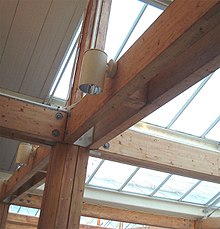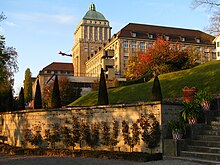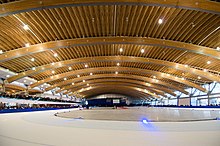Glued laminated timber, also called glulam, is a type of structural timber product comprising a number of layers of dimensioned timber bonded together with durable, moisture-resistant structural adhesives. In North America the material providing the laminations is termed laminating stock or lamstock.
U.S Manufacturing
In 2015, a lumber mill in Riddle, OR, operated by D.R. Johnson Lumber, began production of cross laminated timber panels designed to be used to build multi-story commercial and residential buildings. It was the first U.S. company to produce the panels as components to replace steel and concrete as basic building materials for commercial and residential projects. Architects and developers in Portland, OR, encouraged the production and said they intended to use them for projects already in the planning stages.
- Wikipedia
By laminating a number of smaller pieces of timber, a single large, strong, structural member is manufactured from smaller pieces. These structural members are used as vertical columns or horizontal beams, as well as curved, arched shapes. Glulam is readily produced in curved shapes and it is available in a range of species and appearance characteristics to meet varied end-use requirements. Connections are usually made with bolts or plain steel dowels and steel plates.
Glulam optimizes the structural values of a renewable resource – wood. Because of their composition, large glulam members can be manufactured from a variety of smaller trees harvested from second- and third-growth forests and plantations. Glulam provides the strength and versatility of large wood members without relying on the old growth-dependent solid-sawn timbers. As with other engineered wood products, it reduces the overall amount of wood used when compared to solid sawn timbers by diminishing the negative impact of knots and other small defects in each component board.
Glulam has much lower embodied energy than reinforced concrete and steel, although of course it does entail more embodied energy than solid timber. However, the laminating process allows timber to be used for much longer spans, heavier loads, and complex shapes. Glulam is two-thirds the weight of steel and one sixth the weight of concrete – the embodied energy to produce it is six times less than the same suitable strength of steel. Glulam can be manufactured to a variety of straight and curved configurations so it offers architects artistic freedom without sacrificing structural requirements.
The high strength and stiffness of laminated timbers enable glulam beams and arches to span large distances without intermediate columns, allowing more design flexibility than with traditional timber construction. The size is limited only by transportation and handling constraints.


Glulam frame used for a roof structure
Glulam and Steel
A 2002 case study comparing energy use, greenhouse gas emissions and costs for roof beams found it takes two to three times more energy and six to twelve times more fossil fuels to manufacture steel beams than it does to manufacture glulam beams. It compared two options for a roof structure of a new airport in Oslo, Norway – steel beams and glulam spruce wood beams. The life cycle greenhouse gas emission is lower for the glulam beams. If they are burned at the end of their service life, more energy can be recovered than was used to manufacture them. If they are landfilled, the glulam beams result in greater greenhouse gas emissions than the steel beams. The cost of the glulam beams is slightly lower than the steel beams.
History
One of the earliest still-standing glulam roof structures is generally acknowledged to be the assembly room of King Edward VI College, a school in Bugle Street, Southampton, England, dating from 1866, designed by Josiah George Poole. The building is now the Marriage Room of Southampton Register Office.
Glulam dome roofing the tower of the University of Zurich, built using the Hetzer system in 1911.
Two churches in Northumberland are now thought to have the earliest extant uses: Holy Trinity, Cambo (1842), and Holy Trinity, Horsley (1844), and four 1850s Merseyside churches also feature laminated timbers: St Mary, Grassendale, St Luke, Formby, St Paul, Tranmere and Holy Trinity, Parr Mount, St Helens.
Richmond Olympic Oval intern view
The first industrial patented use was in Weimar, Germany. Here in 1872 Otto Hetzer set up a steam sawmill and carpentry business in Kohlstrasse. Beginning in 1892, he took out a series of patents. DRP No. 63018 was for a ventilated timber floor deck that could be tightened laterally after installation, to compensate for shrinkage. Hetzer continued to patent various ingenious systems, but the first of these that could be compared with subsequently standardised horizontal glulam was DRP No. 197773, dated 1906. This entailed vertical columns which transitioned into curved glued laminated eaves zones, and then became sloped rafters, all in a single laminated unit. Each component, bonded under pressure, comprised three or more horizontally arranged laminations.
In other words, the glulam portal frame was born. In 1895, Hetzer moved his company to Ettersburger Strasse, still in Weimar. At the height of production, in around 1917, he employed about 300 workers, and Müller includes a fine engraving of the railway sidings and works in 1921.
In 1909, the Swiss engineering consultants Terner & Chopard purchased permission to use Hetzer's patent, and employed glulam in a number of projects. These included the former Hygiene Institute, Zurich, 1911, now the main building of the university, where the bell-shaped roof dome is still to be seen.
The technology arrived in North America in 1934 when Max Hanisch, Sr., who had worked with Hetzer at the turn of the century, formed a firm in Peshtigo, Wisconsin to manufacture structural glued laminated timber.
A significant development in the glulam industry was the introduction of fully water-resistant phenol-resorcinol adhesive in 1942. This allowed glulam to be used in exposed exterior environments without concern of gluline degradation. The first U.S. manufacturing standard for glulam was Commercial Standard CS253-63, which was published by the Department of Commerce in 1963. The most recent standard is ANSI/AITC Standard A190.1–02, which took effect in 2002.
The roof of the Centre Pompidou-Metz museum is composed of sixteen kilometers of glued laminated timber. It represents a 90-metre wide hexagon with a surface area of 8,000 m². The glued laminated timber motif forms hexagonal wooden units resembling the cane-work pattern of a Chinese hat.
Sport Structures
Sports structures are a particularly suitable application for wide-span glulam roofs. This is supported by the light weight of the material, combined with the ability to furnish long lengths and large cross-sections. Prefabrication is invariably employed and the structural engineer needs to develop clear method statements for delivery and erection at an early stage in the design. The PostFinance Arena is an example of a wide-span sports stadium roof using glulam arches reaching up to 85 metres. The structure was built in Bern in 1967, and has subsequently been refurbished and extended.
The roof of the Richmond Olympic Oval, built for speed skating events at the 2010 Winter Olympic Games in Vancouver, British Columbia, features one of the world's largest clearspan wooden structures. The roof includes 2,400 cubic metres of Douglas-fir lamstock lumber in glulam beams. A total of 34 yellow-cedar glulam posts support the overhangs where the roof extends beyond the walls.
Glulam Bridges
Pressure-treated glulam timbers or timbers manufactured from naturally durable wood species are well suited for creating bridges and waterfront structures. Wood’s ability to absorb impact forces created by traffic and its natural resistance to chemicals, such as those used for de-icing roadways, make it ideal for these installations. Glulam has been successfully used for pedestrian, forest, highway, and railway bridges. An example in North America of a glulam bridge is at Keystone Wye, South Dakota, constructed in 1966–1967.
Glulam bridge crossing Montmorency River, Quebec.
The Kingsway Pedestrian Bridge in Burnaby, British Columbia, Canada, is constructed of cast-in-place concrete for the support piers, structural steel and glulam for the arch, a post tensioned pre-cast concrete walking deck, and stainless steel support rods connecting the arch to the walking deck.
Sneek, The Netherlands. Heavy-traffic Accoya Glulam Bridge
U.S Manufacturing
In 2015, a lumber mill in Riddle, OR, operated by D.R. Johnson Lumber, began production of cross laminated timber panels designed to be used to build multi-story commercial and residential buildings. It was the first U.S. company to produce the panels as components to replace steel and concrete as basic building materials for commercial and residential projects. Architects and developers in Portland, OR, encouraged the production and said they intended to use them for projects already in the planning stages.
- Wikipedia









No comments:
Post a Comment